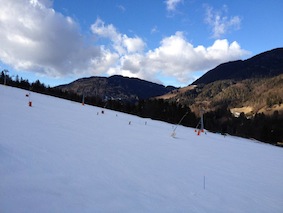Stem cells on the Slovenian slopes
Posted by Katherine Brown, on 6 February 2012
 A couple of weeks ago, around 70 stem cell scientists gathered in the beautiful ski resort of Kranjska Gora, Slovenia, for the sixth meeting organised by the European Stem Cell consortium EuroSyStem. Although the snow wasn’t up to much (as the photo proves – just take a look at the opposite side of the valley!), the lack of fresh powder left more time for the science. And there was a lot of great science to be discussed…
A couple of weeks ago, around 70 stem cell scientists gathered in the beautiful ski resort of Kranjska Gora, Slovenia, for the sixth meeting organised by the European Stem Cell consortium EuroSyStem. Although the snow wasn’t up to much (as the photo proves – just take a look at the opposite side of the valley!), the lack of fresh powder left more time for the science. And there was a lot of great science to be discussed…
Hans Clevers (Hubrecht Institute) kicked things off in the first of two outstanding plenary talks, with the latest developments on intestinal stem cell homeostasis, including beautiful demonstrations of how two innovative technologies – in vitro organoid culture, and the “Brainbow” cell labelling technique – have provided insights into the life of the Lgr5+ crypt stem cell. The name of Charles Leblond came up often in his talk: neither I nor many in the audience had ever heard of him, but his insights into stem cell self renewal, as well as his development of autoradiography, definitely earn him a place in the stem cell Hall of Fame (see here for a summary of his achievements).
The following day took us on a whistle-stop tour of model organisms, with planaria, flies, zebrafish, salamanders and Arabidopsis all taking their turn in the spotlight. After that, mammals took centre stage, with talks covering the whole spectrum of the stem cell field, from lineage determination and ES cell reprogramming, to aging and cancer. Prize for “Unsettling Animal Photo of the Week” (with apologies to the Guardian newspaper for blatant plagiarism of their feature) goes to Tom Rando (Stanford), whose lab has provided striking insights into systemic effects of aging from heterochronic parabiosis experiments – essentially grafting two mice together. Take home message: if you need a blood transfusion, you really want a young person’s blood! Other highlights included a lively debate on the Immortal Strand hypothesis following talks from Shahragim Tajbakhsh (Institut Pasteur) and Peter Lansdorp (Terry Fox Laboratory), and a detour into the molecular mechanisms regulating autophagy from Paul Coffer (University Medical Centre Utrecht).
Finally, the scientific program ended with an impressive demonstration of what money and technical resources can achieve, when coupled with hard work and – most importantly – a sharp nose for sniffing out an interesting story. The second plenary speaker, Huck Hui Ng (Genome Institute of Singapore), presented a tour-de-force analysis of the transcriptional and post-transcriptional networks underlying reprogramming, self-renewal and differentiation.
But the real talking point of the meeting came on the Wednesday evening, when we were fortunate enough to be joined by Arnd Hoeveler from the European Commission, who came to talk about future funding from the EC for stem cell research. While the direction the EC’s framework program is taking – towards funding mainly translational research – may not have gone down universally well with the audience of mostly basic researchers, we were given a fantastic forum to discuss science funding and politics with someone who clearly cares deeply about advancing science in Europe, and who faces a tough challenge to convince the political elite of the importance of the kind of research that this meeting was all about.
I’ve only had the chance to mention a few of the great talks, but all in all this was a fantastic conference, seamlessly organised by the EuroSyStem team. So thanks to them, the speakers and the rest of the participants for putting on an eye-opening and stimulating meeting. Now, if only they could have arranged for better piste conditions, it would have been just perfect!


 (2 votes)
(2 votes)